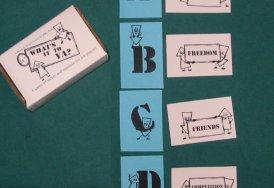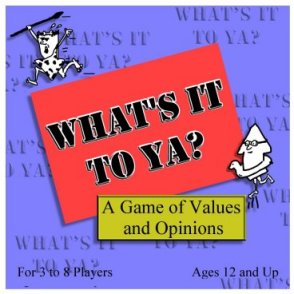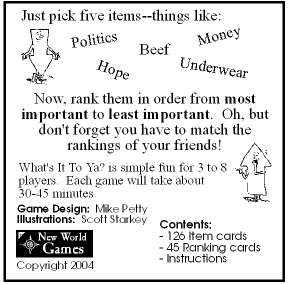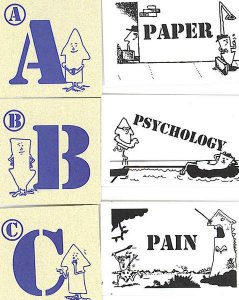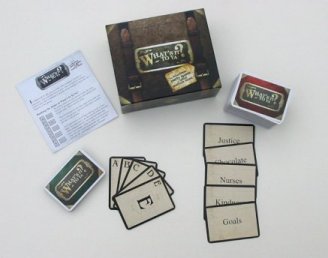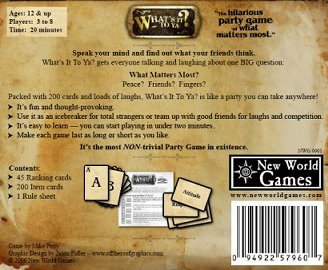 |
|||||||||||||||
|
|||||||||||||||
|
|
|||||||||||||||
Making What’s It To Ya?I was asked to write an article for this website to highlight my experiences of self-publishing my party game, What’s It To Ya?. I’ve worked on the game for about six years now and I’ve sold three versions of it. I’m sure most readers will be interested in hearing about the work involved in creating the current edition, since that’s the one I produced with means typically associated with self-publishing. Still, I think some may find bits from the entire story of the game’s development useful, so I’ll start at the beginning and briefly address its origin and early editions.The earliest stagesI keep a file on my computer that is filled with anything I think of that might make a good game. At one point I pasted in a quote from Einstein that I found interesting. It went like this:“When a man sits with a pretty girl for an hour, it seems like a minute. But let him sit on a hot stove for a minute and it's longer than any hour. That's relativity.” I was fascinated by the thinking behind that quote, how our perceptions of everyday events change when we compare them in new ways. I couldn't help but think there had to be a game there somewhere. Over time I wrote down several rough ideas that involved comparing items or events and ranking them in ways other than by some numeric value. That was six years ago now, so the details are a little hazy, but I believe those rough ideas led to the first prototype of What’s It To Ya?. I remember writing several nouns like “chocolate”, “light” and “politics” on cards. I also came up with a simple way players could rank the items without having to write them down. As is my custom, I asked my wife Kendra to help me try this barely conceived activity of ranking items. I think the question we were supposed to consider as we ranked them was, “Which do you want most?” I drew five random nouns and one of us would rank them from most to least desired. The other would try to guess the rankings. It was fun and I found I wanted to try it with more players right away. I also decided after that short session that perhaps a more interesting question would be, “Which is most important?” My friend Terry Carr and I were getting together during this time to playtest each other’s games and one night I decided to show him this one. With Kendra, Terry and I playing that first time it was immediately clear the core activity was fun, thought provoking and sometimes outright hilarious. There’s a recognizable difference that occurs when playtesting becomes play and that’s what I look for when I’m trying to determine if my games are going in the right direction. That night I knew What’s It To Ya? was something special. Unfortunately, my efforts in game design were moving at a slow crawl during those years. What’s It To Ya? ended up in a box on a stack along with a dozen other games that I felt had promise, but that I never had the time to playtest further. The Black & White versionOver a year later I attended Protospiel 2002 in East Lansing, Michigan. There I met James Droscha (he uses the name James Kyle on his designs). James told the group about his own journey into the industry as a published designer.He recalled how, a couple years prior, he decided to publish a game he created called HellRail. Rather than pay half a year’s wages to produce several thousand copies, he started small and safe with a mere fifty. Those sold out at GenCon in four days. This at least encouraged him enough to make some more copies. He invested more time and money the second time around and produced 500 of them. The rules and components were improved. The game soon caught praise from Games Magazine and from Mayfair Games. His 500 copies sold out and he was offered a contract from Mayfair and later by Franjos in Germany. Since I didn’t have loads of money to spend on printing games, James’ story was very encouraging to me. I loved the idea that a game could still find its way into the industry strictly because it was a fun game. I decided to try his technique with one of my own designs. I didn’t’ start with What’s It To Ya?. I started with a little word game called Yaddy-Yadda, that I knew would be easy to produce. With about $200 I bought enough equipment and supplies to print 50 copies of my game. I called my business Black & White Games and reveled in the fact my games could fit in a small box and sell for less than $5. (Note that I wasn't trying to make any money at this point!) By this time my friend Terry had changed his sights from game design to selling games. He bought Fair Play Games, the online game store, and he graciously allowed me to sell my games through the website.
The Second EditionFor this second edition I contacted Scott Starkey and asked if he’d do the artwork. I knew Scott through my work at Fair Play. His game The Motherlode of Sticky Gulch had caught my attention and we exchanged a few emails. He offered me a great price on some line art. He took the little arrow men (which I so creatively called Up and Down) from my Black and White edition and he went crazy with them! It was very exciting for me to see his creativity and how it gave character to my game. I contacted a local printer and I checked out options for cardstock and printing techniques. This type of work was very different than what the printer was used to, but after a few months of working out the details we ordered enough materials to create 200 copies of the game. Looking back, I wasn't at all pleased with my choice of cardstock and the process for printing the box covers. In May of 2004, though, we received the thousands of cards and hundreds of boxes. Kendra and I set to work on assembling hundreds of copies of our slightly improved version by hand.
The game sold steadily throughout that year. It wasn’t taking the game world by storm, but we felt confident Terry would not lose money on his relatively small investment. Word from customers was positive. I never received a single bad comment about the thin cards or the poor printing on the box. I assumed this was because the price was right and the game was entertaining. My biggest surprise came at the end of October when I discovered the game was selected by Games Magazine for the Games 100! The remaining copies of the game sold out almost immediately after that issue of their magazine hit the stands. When the final figures were in, the game generated an 8% profit. That's not great, but it was encouraging to know we had a game so many people enjoyed. Terry was excited by the interest in the game and he immediately wanted to order a few hundred more of the game. Kendra and I were hesitant, though, since we were the ones assembling each copy! We decided instead we’d try to use the recognition the game received to move it into the hands of a larger publisher. So I spent over half of 2005 doing just that. I sent the game to four publishers that year, each time waiting for their responses. One company kept it for four months with promises of taking a look at it. It was eventually returned with the box unopened, unplayed, but rejected all the same. Many people who have invented a game have gone through similar circumstances and this can be very discouraging. Instead of giving up on What's It To Ya?, though, my wife and I started talking about printing our own edition. I began looking for a printer who could provide is with a larger, high quality print run. That was August of 2005. Printing the New EditionSo, as I mentioned at the start of this article, this brings me to point most designers will be interested in. How did we go about self-publishing a professional edition of the game? Well, before I answer that question, I want to point out three things that made our venture unique.First, I didn’t pay my own money to publish What’s It To Ya?. Shortly after I started scoping out printers Terry informed me he’d still be interested in publishing the new edition again. So throughout the process I haven’t had the experience of knowing my own money was funding an expensive project. Terry is a good friend of mine and I tried hard to make decisions as if it was my money, but I’m sure I don’t fully understand the feeling of putting a huge percentage of my annual income on the line. Secondly, I think we were in a much better position to forge ahead with this printing than many would-be game designers. I had watched many people play my game over the past two years. I knew about couple hundred had purchased the game and many hundreds more had played it. The feedback was consistently positive. After talking to other designers or reading of their experiences, I see most people set out printing their game with far less exposure to the general public. Sure, it took us a lot longer to do it this way. However, I recommend it as opposed to rushing into production with a game that is not fully tested or that has not proven its entertainment value. Last of all, the New World Games version of What’s It To Ya? is unique because Terry Carr owns that company and Fair Play Games. Fair Play is one of the top online retailers of board games. Having the game funded by the owner not only makes it very easy for us to put the game in view of thousands of customers a month, it also allows us to use established relationships with distributors. To put it briefly, we knew from the start we had a much better chance of getting this game into the hands of customers than many others who start a business to self-publish their games. And, while not making the game terribly unique, it is worth mentioning the game has very simple components. The printed materials consist entirely of a box, two decks of cards and a sheet of rules. Each card does not require a different picture. This meant that I only had to pay for five images for artwork. Looking back, this was a great game to start with as I tried my hand at self-publishing on a larger scale. You’ll want to keep that in mind as you read over my experience and suggestions that follow. An overview of the experience So we started looking for printers in August of 2005. My plan was to have the game up for sale by late November. Boy was I off! I ended up having several communication issues, many due to my own inexperience, and the project lurched and crawled forward very slowly over several months. Speaking of communication, keep in mind that during this entire project I was working full time at my real job during the day. I did almost all the communication for the game by email, since I was working on it after business hours. This was a blessing and a curse. Imagine each time a printer used some jargon that was unfamiliar to me in a message. I had to reply with an email and wait another day, sometimes more, for their reply. This made for slow going as some decisions that may have taken hours took weeks. So, now almost exactly a year later, I’m waiting for 3,000 copies to arrive any day. Yes, it took ten months just to get the artwork to the printer and to approve the job. The final two months have been the easiest for us, except for the waiting. It actually took me all the way through October of last year just to determine we were going to produce the game for sure. By then we had narrowed it down to a couple printers in China and we knew Terry would cover the expenses. At the same time I had a verbal commitment from an artist, a friend of mine named Jason Fidler, to provide the artwork. We then lost several weeks trying to decide which printer to go with. We had one based in New York City offering us a very low quote, but unfortunately there was a language barrier we were having trouble dealing with that made things progress slowly. We also had a highly recommended company from the Chicago area that was offering us a workable, but significantly higher, price. After viewing some samples, asking for advice and dealing with several unanswered emails we decided to go with Insight World Group, the company from Chicago. This whole affair took another two months, so it was January, 2006 when we signed the papers with the printer and with Jason, our artist. The next five months were taken up by communications between those two parties. For much of the time I was the go-between. Now, perhaps this was my biggest point of confusion, but I expected the artwork would be done first, based on my preliminary specs (which did stay pretty much the same throughout), then the artist would make it fit the components if last minute changes were necessary. Well, Jason didn’t think it should be done that way, so he waited until everything was finalized with the factory. I’m still not certain if he was right to wait that long or not, but most of these five months were wasted due to this point of disagreement. I remember weeks where I didn’t know where to start. Jason was waiting on the printer for templates, but I wanted to see what the box was going to look like before we made the first down payment. The problem was, the printer wouldn’t send templates until they saw the money. There were several mornings that I left for work wishing I hadn’t checked my email first! Finally in April the factory in China and the offices in Chicago let me know the exact specs for the job. There were some minor changes suggested for the box depth and the width of the rules. With those set, they sent templates to Jason. I set a deadline for the artwork at this point of April 30th. He worked very hard during those weeks and the job took a lot more time than he planned. From the beginning he agreed he’d not only do the art, but he’d help us lay out all the cards and the rules too. It ended up being more work than he had expected, but I can say to his credit he took a personal interest in the job and he turned out some great work. I had told the printer we’d have artwork to them by the first week of May and we were right on time. Just when we breathed a sigh of relief (and I even told Jason I’d have his final check that weekend) we found there was one big problem. The templates they sent Jason were based on my initial dimensions for the box and rules, so they didn’t reflect the changes we agreed upon. I don’t know if that was a mistake or if they just expected Jason to revise them based on their emails. It was a surprise to both of us though, and as you may be able to imagine, Jason was completely frustrated. I’ve worked with and have known enough artists to understand they can be an emotional bunch. Somewhat due to his emotions, and somewhat due to his busy schedule of a full-time job and other freelance projects, it took awhile for him to get back to my graphics. It was a whole month later, in the first weeks of June, that the artwork was finalized and approved by the printer. The proofs for the job came quickly and looked terrific. We had no changes at that point, so from then until now the work has been out of our hands. At the very end of July we received a free case of samples of the game. They look great! A ship is slowly carrying the other 3,000 to port and we expect to have them up for sale by the end of this month.
Now, from what I've been told the work has only begun! Selling them all is another story (that has already started weeks ago) which I’ll save for another article. For now, here is a list of some suggestions I have for anyone considering self-publishing a game like I did. Tips, information and suggestions I found helpful (sometimes too late!)Decide where you want to print.Even before deciding on the printer, decide if you want to print at home or abroad. It seems so many self-publishers are printing in China, since it’s less expensive. I will confirm the quotes we saw for smaller print runs definitely support this. Quality can be a big issue though! I can’t speak much to quality yet since I haven’t seen the vast majority of our 3,000 copies yet. I’ve heard stories, though, and they scare me! Some experienced publishers claim they’d never print in China. So, for advice here, all I can suggest is choose a printer that is referred to you by reliable sources. I contacted a few publishers whom I knew well enough to ask a few simple questions and they gave me names of printers they worked with. We eventually chose Insight World Group because of good recommendations from these sources. As for printers, I’d include a list of possibilities with this article, but at this time I have only worked with Insight. To comment on their service, I’ve been mostly pleased. The template issue I referred to above was the only mistake I felt they made, but even that could have been a misunderstanding on our part. There were a number of times we lost momentum because I didn’t understand their emails. If I could have done more phone conversations this would have been easily avoided. Before contacting any printer for a quote, I strongly suggest you have:
Whenever possible, base your specs on the components of games you own and can use as samples. I based the box and card sizes on a game from Out of the Box. While dimensions are easy to measure, I had a terrible time determining what materials or thicknesses to go with for our game, and remember, our game had very few components! Printers will make suggestions and send samples, but this takes time and it usually will cost upfront, at least for the shipping. I was told by one successful publisher the best way to go is to send them some components from a game that you want to try to match in terms of component quality. I think that’s great advice that would have saved me a few weeks in production time. Be sure all content is complete before you line up the artist and printer. I was still learning how to make a quality game, so I kept writing and re-writing things such as the text I wanted on the box, my written rules and the layout of the cards. I was so inexperienced that this continued even as I was coordinating the job with the printer and my artist. I assumed this process would take long enough that I’d have time to finalize these details as we went along. In reality the printers were very efficient. If I had come to them (and my artist) with everything ready the job, from quote to delivered games, could have been done in about four months. Along these lines, I want to pass along the best advice I gained from Dominic Crapuchettes’ presentation at the Protospiel 2005 gathering. He told us that a game’s box should speak to needs of the target audience, not simply highlight the features of the game. I could see the wisdom of this advice immediately and since that time it’s been interesting looking at games to see how many small publishers try to grab attention by listing features. I remember seeing one self-published game, clearly aimed at the mass market, with the text “uses custom dice” boldly printed on the front of the box. The custom dice in that game were probably a big step in the creation process and the designer was proud of them. But how many people are looking for a game with custom dice? When I wrote the text for the back of our box, I could have boasted of the billions of combinations of item cards that are possible in What’s It To Ya? or I might have pointed out the unique ranking mechanic I developed for the game. Those things didn’t speak to the needs of the people I wanted to reach, though, so I plastered the back of the box with phrases such as:
Besides all the text, you’ll also want a UPC (or possibly an ISBN or other code if you hope to sell internationally) for the game. There are websites selling individual barcodes. I purchased ours through Simply Barcodes. There’s some question as to whether or not this is an acceptable practice, but from all information I’ve read it’s certainly legal and less expensive than buying a block of them through the UCC. Don’t take my word for it, though. You’ll find plenty of useful information from George Laurer, the inventor of the UPC, at this page. Lastly, I suggest you give thought to extra space you may have left on the sheets after the cards are printed. You’ll have to ask the printer about this, but if there will be room left over on one or more sheets, you will want to take advantage of it. In the case of our job we decided too late in the process we’d like to make use of space that would provide seven promotional cards per sheet. We were told it would cost in the neighborhood of $1,500 to make that change at the time we asked. Had we thought of it sooner it would have allowed us to get several thousand promotional cards for next to nothing. Communicate up front with your artist and set clear deadlines. I learned really quickly that my artist trusted me to know the process better than I actually did. Producing a game at this level was new to both of us and I didn’t make that clear to him. I also didn’t set clear deadlines for the artwork. I thought because we were friends, we wouldn't need to be so formal, but the lack of guidelines almost cost us that friendship more than once! Now I'm convinced we could have trimmed a couple months off this job if I had simply set some realistic expectations and deadlines when the contract was signed. Check those proofs carefully! Anyone who attended Alex Yeager’s talk on the first day of Protospiel 2006 will find this advice familiar. I had just approved our proofs for What’s It To Ya? a couple weeks prior to that session and I was sweating! I checked the text on our proofs, but he was calling for a lot more than that. For example, he urged designers to check every picture of every card back, since one inconsistency could lead to a marked deck. I didn’t do that! I thought it was good enough that the card backs appeared to have the right design. Well, from what I’ve seen so far our cards turned out fine, but I pass his advice along. It could avert disaster! Decide how you’ll get the game to you or your warehouse. If you’re printing overseas there’s quite a bit involved with getting your shipment through customs. I talked to one friend who worked through this himself, then I decided to pay the extra and have our printer handle it. Perhaps I could have saved some money, but finding a good broker and being on hand to answer phone calls as the shipment worked its way through customs the day it arrived didn’t sound like fun. If I chose a bad broker it could actually have ended up costing me more money. In the end I was very glad Insight was willing and able to handle this for us. Along with this, I should mention that the price for handling the delivery jumped up about twelve cents per unit because our game ended up being printed about three months later than I had told them. There are peak times I’m grateful this is the only surprise cost we had, and it was less than $500. Still, it could have been avoided if I’d been more wise with deadlines for myself and others throughout the process. Be in contact with distributors well before the game is released. As I said earlier, I don’t want to get too heavily into sales and distribution. However, I learned a little too late that distributors should be notified of the game three months before the release date of a game. Their catalogs are printed months ahead of time and it’s to your advantage to be listed in them in advance. Also, you probably know it’s not easy to get a distributor to pick up your first game. So, add time on top of the three months just so you can contact distributors and check out the possibility that they’ll carry the game. So, that's the story of my first six years of working with What's It To Ya?. I've left out a lot of details, most notably the fun we've had demoing the game or running events as it has gained in popularity. If things go as well as expected with this new edition, I'll be sure to include those experiences as well in a follow-up article on promoting and selling a game. Update four years later... Now that it's 2010 it is interesting reading that article again! Yes, 3,000 copies of What’s It To Ya? arrived at the end of summer in 2006 and, for the most part, we failed miserably at selling all of them! Within a few months I realized it was going to be harder than I expected. I think the advice from 2006 is good, but if I was doing it again I would also:
My personal goal was to sell all the copies off by the end of 2007. If I remember right, we hadn’t even sold a third of them by that time. We continued giving away review copies and running promotions to draw attention to the game. I think ultimately we struggled because all my experience was with the hobby game market, but this game was better suited for the mass market. My friend Dominic Crapuchettes gave us lots of great advice on how to move in that direction, but they required greater financial risk than we were allowed to take. In early 2009 I finally gave up on pushing the game. After trying to get it some attention through three holiday seasons with less success each year, I let it go. But I’m glad to say that wasn’t the end of the story. Shortly after that decision I received an email from Tim Walsh. Tim had enjoyed a ton of success in the game industry back in the nineties with hits like Blurt and Tri-Bond. He now works as an agent selling games to large publishers and everyone I’ve talked to speaks highly of his work and his personal integrity. Tim had purchased a copy of What’s It To Ya? and played it with his family. He said that he thought he could sell it and, interestingly, that God had brought us together at just this time. I’m all up for keeping in step with the Almighty, so I considered my options. I discussed it with New World Games, since any new deal for the game would impact their chances of selling their remaining stock. With their understanding and support I signed a contract with Tim. Within eight months he got us a contract with Find It Games. Their original creation, the Find It game/puzzle, has been a runaway success and now they are trying their hand at some other products. What’s It To Ya? is their first step in the party game arena. Just this week, almost 10 years after I played that first prototype with my wife, I received seven cases of my game in its latest form. The publisher renamed it Oh, Really and they changed a few rules. I would have suggested some changes to their edition, but overall it looks great. I’m very happy to have the game in their hands and I look forward to seeing how it sells. The game's page at Find It is here: Oh, Really! Everyone who has seen their game reach this point has their own story. All things considered, my lesson in all of this has been to be patient. From the photocopied first edition until now, it has been a waiting game with many factors beyond my control. There are very few things in the process that I can point to and say that my input made a huge difference. In my case, the game caught attention slowly and I am left feeling grateful for the current state of things far more than feeling that I've accomplished something. Of course, having a game in many stores across the U.S. would not a very satisfying end to this story. Only time will tell if it is successfully reaches many people and serves its purpose. So the waiting continues! |
|||||||||||||||
| |
|||||||||||||||
| this page last updated 20 August 2010 |
